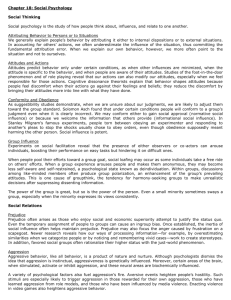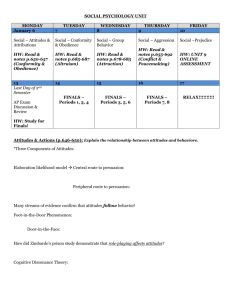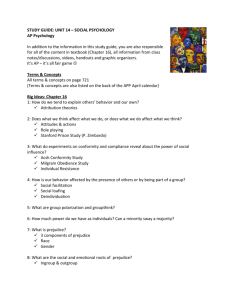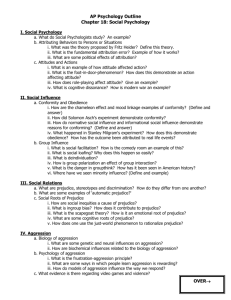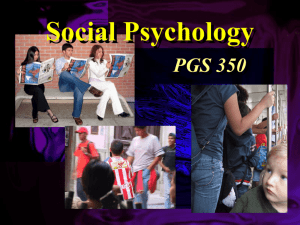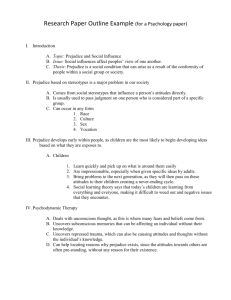File - Thrive in AP Psychology
advertisement
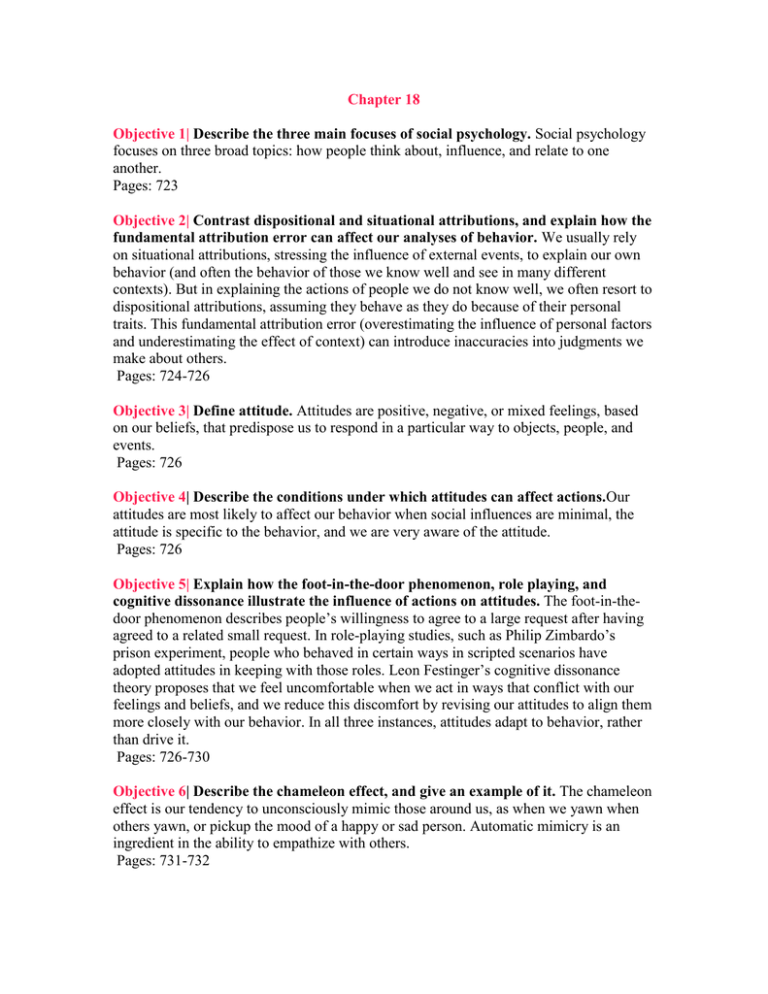
Chapter 18 Objective 1| Describe the three main focuses of social psychology. Social psychology focuses on three broad topics: how people think about, influence, and relate to one another. Pages: 723 Objective 2| Contrast dispositional and situational attributions, and explain how the fundamental attribution error can affect our analyses of behavior. We usually rely on situational attributions, stressing the influence of external events, to explain our own behavior (and often the behavior of those we know well and see in many different contexts). But in explaining the actions of people we do not know well, we often resort to dispositional attributions, assuming they behave as they do because of their personal traits. This fundamental attribution error (overestimating the influence of personal factors and underestimating the effect of context) can introduce inaccuracies into judgments we make about others. Pages: 724-726 Objective 3| Define attitude. Attitudes are positive, negative, or mixed feelings, based on our beliefs, that predispose us to respond in a particular way to objects, people, and events. Pages: 726 Objective 4| Describe the conditions under which attitudes can affect actions.Our attitudes are most likely to affect our behavior when social influences are minimal, the attitude is specific to the behavior, and we are very aware of the attitude. Pages: 726 Objective 5| Explain how the foot-in-the-door phenomenon, role playing, and cognitive dissonance illustrate the influence of actions on attitudes. The foot-in-thedoor phenomenon describes people’s willingness to agree to a large request after having agreed to a related small request. In role-playing studies, such as Philip Zimbardo’s prison experiment, people who behaved in certain ways in scripted scenarios have adopted attitudes in keeping with those roles. Leon Festinger’s cognitive dissonance theory proposes that we feel uncomfortable when we act in ways that conflict with our feelings and beliefs, and we reduce this discomfort by revising our attitudes to align them more closely with our behavior. In all three instances, attitudes adapt to behavior, rather than drive it. Pages: 726-730 Objective 6| Describe the chameleon effect, and give an example of it. The chameleon effect is our tendency to unconsciously mimic those around us, as when we yawn when others yawn, or pickup the mood of a happy or sad person. Automatic mimicry is an ingredient in the ability to empathize with others. Pages: 731-732 Objective 7| Discuss Asch’s experiments on conformity, and distinguish between normative and informational social influence. Solomon Asch found that people will conform to a group’s judgment even when it is clearly incorrect. Conformity increases when we feel incompetent or insecure, admire the group’s status and attractiveness, have made no prior commitment to a response, are being observed by members of the group, come from a culture that strongly encourages respect for group standards, and are in a group with at least three members, all unanimous in their decision. We may conform either to gain social approval (normative social influence) or because we welcome the information that others provide (informational social influence). We are most open to informational social influence if we are unsure of what is right and being right matters. Pages: 732-734 Objective 8| Describe Milgram’s experiments on obedience, and outline the conditions in which obedience was highest. In Stanley Milgram’s experiments, people torn between obeying an experimenter and responding to another’s pleas to stop the shocks usually chose to obey orders, even though obedience supposedly meant harming the other person. People were most likely to obey when the person giving orders was nearby and was perceived as a legitimate authority figure; when the person giving orders was supported by a prestigious institution; when the victim was depersonalized or at a distance; and when no other person modeled defiance by disobeying. Pages: 734-737 Objective 9| Explain how the conformity and obedience studies can help us understand our susceptibility to social influence. In the conformity studies, randomly chosen ordinary people conformed in spite of their own beliefs. In the obedience studies, randomly chosen ordinary people obeyed instructions to deliver punishments that, if real, would have harmed total strangers. People who resisted instructions did so early; after that, attitudes followed behavior. If we learn from these experiments the underlying processes that can shape our behavior, we may be less susceptible to powerful social influences in real-life situations in which we must choose between adhering to our own standards or being responsive to others. Pages: 737 Objective 10| Describe the conditions in which the presence of others is likely to result in social facilitation, social loafing, or deindividuation. The presence of either observers or co-actors boosts arousal, strengthening our most likely response. This social facilitation tends to increase performance on easy or well-learned tasks but decrease it on difficult or newly learned ones. The presence of others pooling their efforts toward a group goal can decrease performance when social loafing occurs, as some individuals ride free on the efforts of others. Deindividuation, a psychological state in which people become less self-aware and self-restrained, may result when a group experience arouses people and makes them feel anonymous. Pages: 738-739 Objective 11| Discuss how group interaction can facilitate group polarization and groupthink. Within groups, discussions among like-minded members often produce group polarization, an enhancement of the group’s prevailing opinions. This process fosters groupthink, as groups pressure members to conform, suppress dissenting information, and fail to consider alternatives. To prevent groupthink, leaders can welcome a variety of opinions, invite experts’ critiques, and assign people to identify possible problems in developing plans. Pages: 739-741 Objective 12| Identify the characteristic common to minority positions that sway majorities. Minorities that successfully sway group opinions usually express their views consistently. Pages: 741 Objective 13| Identify the three components of prejudice. Prejudice is an attitude composed of beliefs, emotions, and predispositions to action. The beliefs are frequently stereotypes (sometimes accurate but often overgeneralized beliefs). The emotions are most often negative, and the action is usually discrimination (unjustifiable negative behavior). Pages: 743 Objective 14| Contrast overt and subtle forms of prejudice, and give examples of each. Overt prejudice, such as denying a particular ethnic group the right to vote, is discrimination that explicitly (openly and consciously) expresses negative beliefs and emotions. Subtle prejudice, such as feeling fearful in the presence of a stranger with a particular ethnic background, is an implicit (often unconscious) expression of negative beliefs and emotions. Pages: 743-745 Objective 15| Discuss the social factors that contribute to prejudice. One social factor contributing to prejudice is inequality (unequal distribution of money, power, and prestige) within a group; in such conditions, the “haves” usually develop negative attitudes toward the “have-nots” to justify their more privileged positions. Definitions of social identity (“we” the ingroup versus “they” the outgroup) are another source of prejudice because they promote ingroup bias (a tendency to favor one’s own group) and discrimination. Pages: 745-747 Objective 16| Explain how scapegoating illustrates the emotional component of prejudice. Troubled times, especially those that remind us of our own mortality, produce feelings of fear and anger. As in-group loyalty and out-group prejudice intensify, people may search for a scapegoat—someone to blame for the troubling event. Such denigrating of despised others can boost in-group members’ self-esteem. Pages: 747 Objective 17| Cite four ways that cognitive processes help create and maintain prejudice. We simplify the world around us by creating categories, but when we categorize people, we often stereotype them, overgeneralizing their characteristics andunderestimating their differences. We also tend to judge the frequency of events by vivid cases (violence, for example) that come to mind more readily than the long string of less vivid events involving the same group. We may justify people’s less-privileged or punished position by the just-world phenomenon, assuming that the world is just and people get what they deserve. Hindsight bias (the tendency to believe, after learning an outcome, that we would have predicted it beforehand) may contribute to this tendency to blame the victim. Pages: 747- 748 Objective 18| Explain how psychology’s definition of aggression differs from everyday usage. Psychology’s definition of aggression is “any physical or verbal behavior intended to harm or destroy.” This is more precise than the everyday definition of aggression and includes behaviors (such as killing in combat) that might not be included in everyday usage. Pages: 749 Objective 19| Describe three levels of biological influences on aggression.Psychologists dismiss the idea that aggression is instinctual and confirm that it results from an interaction between biology and experience. Genes influence aggression, for example by influencing our temperament. Experiments stimulating portions of the brain (such as the amygdala and frontal lobes) demonstrate that the brain has neural systems that facilitate or inhibit aggression. Studies of the effect of hormones (such as testosterone), alcohol (which releases inhibitions), and other substances show that biochemical influences also contribute to aggression. Pages: 749-750 Objective 20| Outline four psychological triggers of aggression. Biological conditions set the threshold for aggressiveness, but psychological factors trigger aggressive behaviors. Aversive events (such as environmental conditions or social rejection) can create frustration, leading to feelings of anger and hostility. Reinforcement for aggressive behavior (such as gaining a treat from another student by bullying) can establish learned patterns of aggression that are difficult to change. People can also learn aggression and become desensitized to violence by observing models act aggressively in person (watching violence within the family or neighborhood, for example) or in the media (watching violence or sexual aggression on TV or in movies). Media depictions of violence can trigger aggression in another way: by providing social scripts (culturally sanctioned ways of acting in a given situation). Pages: 751-754 Objective 21| Discuss the effects of violent video games on social attitudes and behavior. Violent video games can heighten aggressive behavior by providing social scripts and opportunities to observe modeled aggression and to role-play aggression. Playing these games can increase arousal and feelings of hostility; prime aggressive thoughts and increase aggression; and (in adolescents) lead to increased participation in arguments and fights and falling grades. Virtual reality games may heighten these effects. Pages: 754-756 Objective 22| Explain how social traps and mirror-image perceptions fuel social conflict. Social conflicts are situations in which people perceive their actions, goals, or ideas to be incompatible. In social traps, two or more individuals engage in mutually destructive behavior by rationally pursuing their own personal interests without regard for the well-being of others. Helping people to agree on regulations, communicate better, and be more aware of responsibilities toward others can foster cooperation and avoid social traps. People in conflict tend to perceive the worst in each other, producing mirrorimages of identical demons. The perceptions can become self-fulfilling prophecies, triggering reactions that confirm the images. Pages: 756-758 Objective 23| Describe the influence of proximity, physical attractiveness, and similarity on interpersonal attraction. Proximity—geographical nearness—promotes attraction, in part because it increases the opportunities for interaction and in part because of the mere exposure effect (repeated exposure to novel stimuli enhances liking). Physical attractiveness also increases opportunities for interaction. People prefer being with attractive people and perceive them as healthier, happier, more sensitive, more successful, and more socially skilled. Judgments of attractiveness vary by culture, and as time goes by we find those we care about to be more attractive. Similarity of attitudes and interests greatly increases liking after people make it past the first impression. The reward theory of attraction states that we tend to like people whose behavior is rewarding to us, and we will continue relationships that offer more rewards than costs. Pages: 758-762 Objective 24| Describe the effect of physical arousal on passionate love, and identify two predictors of enduring companionate love. Associating arousal with a desirable person is a key ingredient of passionate love, the intense absorption we cognitively label as love. Passionate love often matures into the deep affectionate attachment of companionate love. This transition is most likely in relationships characterized by equality and intimate self-disclosure. Pages: 762-764 Objective 25| Define altruism, and give an example. Altruism is the unselfish regard for the welfare of others. Examples of altruism include helping victims of a natural disaster, giving blood, or donating to local food pantries with no expectation of personal reward. Pages: 764-765 Objective 26| Describe the steps in the decision-making process involved in bystander intervention. The bystander effect is the tendency, identified by John Darley and Bibb Latané, for any given observer to be less likely to help if others are present. To offer help, a person must notice the incident, interpret it as an emergency, and assume responsibility for offering help. Diffusion of responsibility lowers the likelihood of helping. Odds of helping are highest when the victim is similar to us and appears to need and deserve help, and when we observe others helping, are feeling guilty, are not in a hurry or preoccupied, are in a small town or rural area, and are in a good mood. Pages: 765-766 Objective 27| Explain altruistic behavior from the perspective of social exchange theory and social norms. Social exchange theory proposes that our social behaviors— even altruistic, helpful acts—are based on self-interest: maximizing our benefits (which may include our own good feelings) and minimizing our costs. Social norms influence altruistic behaviors by telling us how we should behave. The reciprocity norm is the expectation that we will help those who help us, and the social-responsibility norm is the expectation that we will help those who are dependent on us. Pages: 766-767 Objective 28| Discuss effective ways of encouraging peaceful cooperation and reducing social conflict. Friendly contact between prejudiced people can change attitudes. But social conflict is most likely to be reduced when the circumstances favor cooperation to achieve superordinate goals (especially if subgroups disappear), understanding through communication (sometimes with the help of a third party), and reciprocated conciliatory gestures (such as the GRIT strategy). Pages: 767-770
